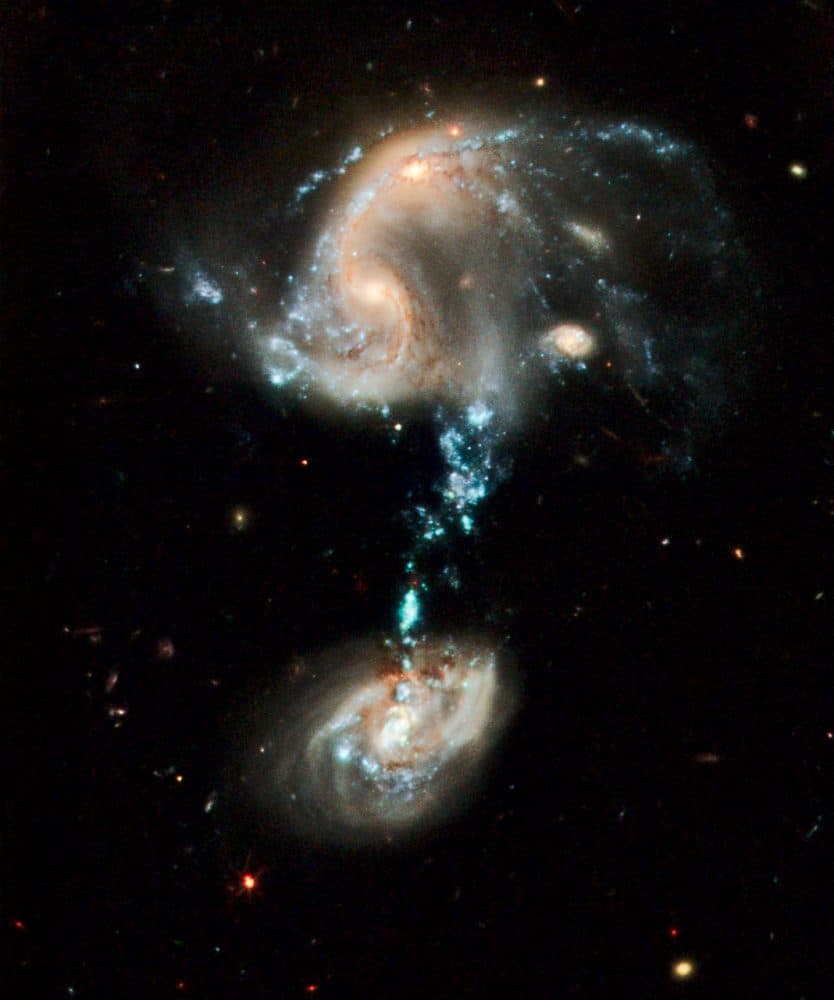Blog
UGC 6093 is something known as a barred spiral galaxy — it has beautiful arms that swirl outwards from a bar slicing through the galaxy’s centre. It is classified as an active galaxy, which means that it hosts an active galactic nucleus, or AGN: a compact region at a galaxy’s centre within which material is dragged towards a supermassive black hole. As this black hole devours the surrounding matter it emits intense radiation, causing it to shine brightly.
But UGC 6093 is more exotic still. The galaxy essentially acts as a giant astronomical laser that spews out light at microwave, not visible, wavelengths — this type of object is dubbed a megamaser (maser being the term for a microwave laser). Megamasers such as UGC 6093 can be some 100 million times brighter than masers found in galaxies like the Milky Way.
more...Lewis Brian Hopkin Jones (28 February 1942 – 3 July 1969) was an English musician, best known as the founder and the original leader of the Rolling Stones. Initially a slide guitarist, Jones would go on to play a wide variety of instruments on Rolling Stones recordings and in concerts, such as rhythm and lead guitar, slide guitar, upright bass, sitar, dulcimer, various keyboard instruments such as piano and mellotron, marimba, harmonica, wind instruments such as recorder, saxophone, drums and numerous others.
Jones and fellow guitarist Keith Richards developed a unique style of guitar play that Richards refers to as the “ancient art of weaving” where both players would play rhythm and lead parts together; Richards would carry the style on with later Stones guitarists and the sound would become a Rolling Stones trademark.
After he founded the Rolling Stones as a British blues outfit in 1962, and gave the band its name, Jones’ fellow band members Mick Jagger and Keith Richards began to take over the band’s musical direction, especially after they became a successful songwriting team. Jones also did not get along with the band’s manager, Andrew Loog Oldham, who pushed the band into a musical direction at odds with Jones’ blues background. At the same time, Jones developed alcohol and drugs problems, and his performance in the studio became increasingly unreliable, leading to a diminished role within the band he had founded. In June 1969, the Rolling Stones asked Jones to leave; guitarist Mick Taylor took his place in the group. Jones died less than a month later, drowning in the swimming pool at his home while under the influence of alcohol and drugs.
Long-time Rolling Stones bass guitarist Bill Wyman said of Jones, “He formed the band. He chose the members. He named the band. He chose the music we played. He got us gigs. … he was very influential, very important, and then slowly lost it – highly intelligent – and just kind of wasted it and blew it all away.
more...John Aloysius Fahey (/ˈfæhi/; February 28, 1939 – February 22, 2001) was an American fingerstyle guitarist and composer who played the steel-string acoustic guitar as a solo instrument. His style has been greatly influential and has been described as the foundation of American Primitive Guitar, a term borrowed from painting and referring mainly to the self-taught nature of the music and its minimalist style. Fahey borrowed from the folk and blues traditions in American roots music, having compiled many forgotten early recordings in these genres. He would later incorporate 20th-century classical, Portuguese, Brazilian, and Indian influences into his work.
He spent many of his later years in poverty and poor health, but enjoyed a minor career resurgence with a turn towards the avant-garde. He also created a series of abstract paintings in his final years. Fahey died in 2001 from complications from heart surgery. In 2003, he was ranked 35th on Rolling Stone magazine’s “100 Greatest Guitarists of All Time” list.
Fahey was born into a musical household in Washington, D.C. in 1939. Both his father, Aloysius John Fahey, and his mother, Jane (née Cooper), played the piano. In 1945, the family moved to the Washington suburb of Takoma Park, Maryland, where his father lived until his death in 1994. On weekends, the family attended performances of the top country and bluegrassacts of the day, but it was hearing Bill Monroe‘s version of Jimmie Rodgers‘ “Blue Yodel No. 7” on the radio that ignited the young Fahey’s passion for music.
In 1952, after being impressed by guitarist Frank Hovington, whom he met while on a fishing trip, he purchased his first guitar for $17 from a Sears, Roebuck catalogue. Along with his budding interest in the guitar, Fahey was attracted to record-collecting. While his tastes ran mainly in the bluegrass and country vein, Fahey discovered his love of early blues upon hearing Blind Willie Johnson‘s “Praise God I’m Satisfied” on a record-collecting trip to Baltimore with his friend and mentor, the musicologist Richard K. Spottswood. Much later, Fahey compared the experience to a religious conversion; he remained a devout disciple of the blues for the rest of his life.
more...Willie Bobo was the stage name of William Correa (February 28, 1934 – September 15, 1983), a Latin and jazz percussionist of Puerto Rican ancestry.
William Correa grew up in Spanish Harlem, New York City. He made his name in Latin Jazz, specifically Afro-Cuban jazz, in the 1960s and 1970s, with the timbales becoming his favoured instrument. He met Mongo Santamaría shortly after his arrival in New York and studied with him while acting as his translator, and later at the age of 19 joined Tito Puente for four years.
The nickname Bobo is said to have been bestowed by the jazz pianist Mary Lou Williams in the early 1950s.
His first major exposure was when he joined George Shearing‘s band on the album The Shearing Spell. After leaving Shearing, Cal Tjader asked Bobo and Santamaría to become part of the Cal Tjader Modern Mambo Quintet, who released several albums as the mambo craze reached fever pitch in the late ’50s. Reuniting with his mentor Santamaría in 1960, the pair released the album Sabroso! for the Fantasy label. Bobo later formed his own group, releasing Do That Thing/Guajira with Tico and Bobo’s Beat and Let’s Go Bobo for Roulette, without achieving huge penetration.
more...Arp 194 comprises a group of galaxies of which at least two are in the process of merging. The merging galaxies, seen in the upper portion of the image, display two bright galactic cores that shine with the yellow light of aging stars. These galaxies have been greatly distorted by their mutual gravitational interaction as can be seen in the dusty, chaotic, spiral features. The smaller bright galaxy to the right of the merging pair is in the background and is not involved in the merger. Perhaps the most striking feature of the merger is the fountain of brilliant, newly formed, star clusters extending from the southern, or lower, portion of the merging galaxies. This string of star cluster seems to be connected to the large galaxy in the lower part of the image. This galaxy, however, is located behind the two merging galaxies. It is unclear if this galaxy actually contributed to the interaction of the merger.
The Arp 194 merger is taking place approximately 600 million light years distant and is located in the constellation of Ursa Major.
This image was assembled with data obtained from the Hubble Legacy Archive. Three filtered images were used for the red, green and blue channels. These were imaged using filters of f815w for red, f555w for green and f450w for blue. A luminance channel was created by combining the three filtered images. The color image was created as a standard LRGB image.
more...
Dexter Gordon (February 27, 1923 – April 25, 1990 LA,CA) was an American jazz tenor saxophonist. He was one of the first players of the instrument in the bebop idiom of musicians such as Charlie Parker, Dizzy Gillespie, and Bud Powell. Gordon’s height was 6 feet 6 inches (198 cm), so he was also known as “Long Tall Dexter” and “Sophisticated Giant”. His studio and performance career spanned over 40 years.
Gordon’s sound was commonly characterized as being “large” and spacious and he had a tendency to play behind the beat. He was known for humorously inserting musical quotes into his solos, with sources as diverse as popular tunes, “Happy Birthday”, and the operas of Wagner. This is not unusual in common-practice jazz improvisation, but Gordon did it frequently enough to make it a hallmark of his style. One of his major influences was Lester Young. Gordon, in turn, was an early influence on John Coltrane and Sonny Rollins. Rollins and Coltrane then influenced Gordon’s playing as he explored hard bop and modal playing during the 1960s.
Gordon was known for his genial and humorous stage presence. He was an advocate of playing to communicate with the audience. A photograph by Herman Leonard of Gordon taking a smoke break at the Royal Roost in 1948 is one of the iconic images in jazz photography. Cigarettes were a recurring theme on covers of Gordon’s albums. One of his idiosyncratic rituals was to recite lyrics from each ballad before playing it.
Gordon was nominated for an Academy Award for Best Actor in a Leading Role for his performance in the Bertrand Tavernier film Round Midnight (Warner Bros, 1986), and he won a Grammy for Best Jazz Instrumental Performance, Soloist, for the soundtrack album The Other Side of Round Midnight (Blue Note Records, 1986). He also had a cameo role in the 1990 movie Awakenings.
more...Chuck Wayne (February 27, 1923 – July 29, 1997 NY, NY) was a jazz guitarist. He came to prominence in the 1940s, and was among the earliest jazz guitarists to play in the bebop style. Wayne was a member of Woody Herman‘s First Herd, the first guitarist in the George Shearing quintet, and Tony Bennett‘s music director and accompanist. He developed a systematic method for playing jazz guitar.
Wayne was known for a bebop style influenced by saxophone players of his time, especially Charlie Parker and Coleman Hawkins. In an era when many guitarists used four-square, mandolin-style picking, with rigid up-down stroke articulation, Wayne developed a technique not widely adopted by others until decades later. He also developed a comprehensive approach to guitar chords and arpeggios – based on generic tetrad forms spanning all possible inversions, in varying degrees of open voicing. This highly analytic approach to the fretboard was later documented in a series of theory books, some released posthumously.
more...A new study published this month in the journal Astronomy and Astrophysics details new observations of a 1,300-light-year-long cluster of more than 4,000 stars that have been moving together through the southern sky for about a billion years now. Distributed like a river of bright lights, a cluster like this has never been found so close to Earth, and could create some useful opportunities for learning about the structure and evolution of the galaxy.
“Similar stream-like structures have been known for quite a while now,” says Stefan Meingast, a researcher from the University of Vienna and the lead author of the new study. They are typically considered remnants of more globular clusters or dwarf galaxies that have been pulled apart and distorted over time, but still share a pattern of movement that hint at a shared origin.
Previous streams have been found in the outskirts of the Milky Way. “Our stream, however, is the first one that was found inside the galaxy, in the immediate vicinity of the sun,” says Meingast. “It therefore is a unique probe for studying the evolution of clusters and for measuring the gravity field of the galaxy.”
There had been previous hints that such a stream existed, through some scattered observations. But this latest investigation is the first to confirm that this is a big, coherent structure. What changed? The European Space Agency’s Gaia mission. An audacious project launched in 2013, Gaia plans to catalog over 1 billion astronomical objects and provide the most precise 3D map of the galaxy ever made.
Yes, it’s a bit strange to think a cluster of stars this large was simply hiding in plain sight for so long, but astronomers know better than to feel embarrassed. When you think about how extraordinarily large space is, trying to locate even several thousand stars streaming through the galaxy is “truly like searching for the needle in the haystack,” says Meingast.
The team was initially tasked with simply using the Gaia data to locate groups of stars that were moving together, and eventually they came across the “structure” of these stars that were moving as a group. The team pinpointed only about 200 stars; the 4,000 figure, and their 1-billion-year age, are extrapolations based on an analysis of stellar brightness, distance, and other factors.
more...Najwa Karam (Arabic: نجوى كرم Lebanese pronunciation: [ˈnaʒwa ˈkaɾam]; born 26 February 1966) is a Lebanese singer and songwriter. She has sold upwards of 60 million records in the world, with each album becoming a best-seller. Karam, widely known for her vocal powerhouse dabka talents, gained an international audience for her distinct blend of traditional Lebanese music and contemporary sounds and contributed to the spread of the Lebanese dialect in Arabic Music. In 2011, Karam debuted as a judge on the reality competition television series, Arabs Got Talent; she has since appeared on all five of its seasons. Najwa Karam is one of the highest selling Arabic language singers and holds the records for highest selling Arabic language album during the years of 1999, 2000, 2001, 2003, 2004, 2008 and 2011. In 2017, Forbes Middle East ranked Karam number 5 on the list of “The Top 100 Arab Celebrities” with 26.58 million social media followers. In 2018, Cosmopolitan included Karam on their list of “The 15 Most Inspiring Women In The Middle East”, and Forbes included Najwa Karam on their list of the “Top 10 of Arab Stars On The Global Stage”.
Karam rose to stardom throughout the 1990s, earning the moniker, Shams el-Ghinnieh (“The Sun of Song”), from her eponymous album and topping the charts throughout the Arab Worldwith her albums, Naghmet Hob, Ma Bassmahlak, Maghroumeh, and Rouh Rouhi. In 2000, Karam’s tenth album Oyoun Qalbi became her highest selling album. In 2001 her album Nedmaneh sold millions of copies worldwide, earning Karam a Murex d’Or award for Best Arabic Artist and Rotana Records awards including, Artist of the Year, Album of the Year, and Highest-Selling Album of the Year. By the time her record Saharni was released in 2003, she had established herself as one of the most prominent Lebanese singers and as a Middle Eastern pop icon.
https://www.youtube.com/watch?v=gCAzCs7eiI8
more...Johnny Cash (born J.R. Cash, February 26, 1932 – September 12, 2003 Kingsland, AR) was an American singer-songwriter, guitarist, actor, and author. He is one of the best-selling music artists of all time, having sold more than 90 million records worldwide. Although primarily remembered as a country music icon, his genre-spanning songs and sound embraced rock and roll, rockabilly, blues, folk, and gospel. This crossover appeal won Cash the rare honor of being inducted into the Country Music, Rock and Roll, and Gospel Music Halls of Fame.
Cash was known for his deep, calm bass-baritone voice, the distinctive sound of his Tennessee Three backing band characterized by train-sound guitar rhythms, a rebelliousness coupled with an increasingly somber and humble demeanor, free prison concerts,[8][9] and a trademark, all-black stage wardrobe, which earned him the nickname “The Man in Black.” He traditionally began his concerts by simply introducing himself, “Hello, I’m Johnny Cash,” followed by his signature song “Folsom Prison Blues“.
Much of Cash’s music contained themes of sorrow, moral tribulation, and redemption, especially in the later stages of his career.[4][12] His other signature songs include “I Walk the Line“, “Ring of Fire“, “Get Rhythm“, and “Man in Black“. He also recorded humorous numbers like “One Piece at a Time” and “A Boy Named Sue“; a duet with his future wife, June Carter, called “Jackson” (followed by many further duets after their wedding); and railroad songs including “Hey, Porter“, “Orange Blossom Special“, and “Rock Island Line“. During the last stage of his career, Cash covered songs by several late 20th-century rock artists, notably “Hurt” by Nine Inch Nails and “Rusty Cage” by Soundgarden.
more...Antoine “Fats” Domino Jr. (February 26, 1928 – October 24, 2017) was an American pianist and singer-songwriter. One of the pioneers of rock and roll music, Domino sold more than 65 million records.Between 1955 and 1960, he had eleven Top 10 hits. His humility and shyness may be one reason his contribution to the genre has been overlooked.
During his career, Domino had 35 records in the U.S. Billboard Top 40, and five of his pre-1955 records sold more than a million copies, being certified gold. His musical style was based on traditional rhythm and blues, accompanied by saxophones, bass, piano, electric guitar, and drums.
His 1949 release “The Fat Man” is widely regarded as the first million-selling Rock ‘n Roll record. One of his most famous songs is “Blueberry Hill”.
Antoine Domino Jr, was born and raised in New Orleans, Louisiana, the youngest of eight children born to Antoine Caliste Domino (1879–1964) and Marie-Donatille Gros (1886–1971). The Domino family was of French Creole background, and Louisiana Creole was his first language.
more...This is the last post of ECHOS OF FREEDOM. I created the posts in response to the incredulous and immoral WH administration of our current day; continually discrediting the foundation and moral fiber of our constitution and premise of the United States of America. Let us continue to hear the Echos of Freedom expressed by our historic & present heroes for Freedom, Free Speech, Free Press, Scientific & Medical Freedom and the ultimate objective and brilliant light of truth and justice for all Americans and People of All Cultures.
“I say to you that our goal is freedom, and I believe we are going to get there because however much she strays away from it, the goal of America is freedom. Abused and scorned though we may be as a people, your destiny is tied up in the destiny of America.” MLK
more...
Previously unseen details of a mysterious, complex structure within the Carina Nebula (NGC 3372) are revealed by this image of the ‘Keyhole Nebula, ‘ obtained with the Hubble Space Telescope. The picture is a montage assembled from four different April 1999 telescope pointings with Hubble’s Wide Field Planetary Camera 2, which used six different colour filters. The picture is dominated by a large, approximately circular feature, which is part of the Keyhole Nebula, named in the 19th century by Sir John Herschel. This region, about 8000 light-years from Earth, is located adjacent to the famous explosive variable star Eta Carinae, which lies just outside the field of view toward the upper right. The Carina Nebula also contains several other stars that are among the hottest and most massive known, each about 10 times as hot, and 100 times as massive, as our Sun.
more...More Posts
- Daily Roots with Tony Clarke
- The Cosmos with M83
- Larry Carlton
- Lou Reed
- Doug Watkins
- Maxwell Street Jimmy Davis
- Eddie “Lockjaw” Davis
- World Music with Carlos Cortés Bustamante
- Daily Roots with Paul Hayden
- The Cosmos with NGC 2336
- Burning Spear
- Ralph Towner
- Benny Powell
- Harry Bellafonte
- Charlie Rice
- World Music with the Warsaw Village Band
- Daily Roots with the Vibes Tone
- Surviving the Pandemic and Realizing Racial Justice
- The Cosmos with IC 5063
- Brian Jones




